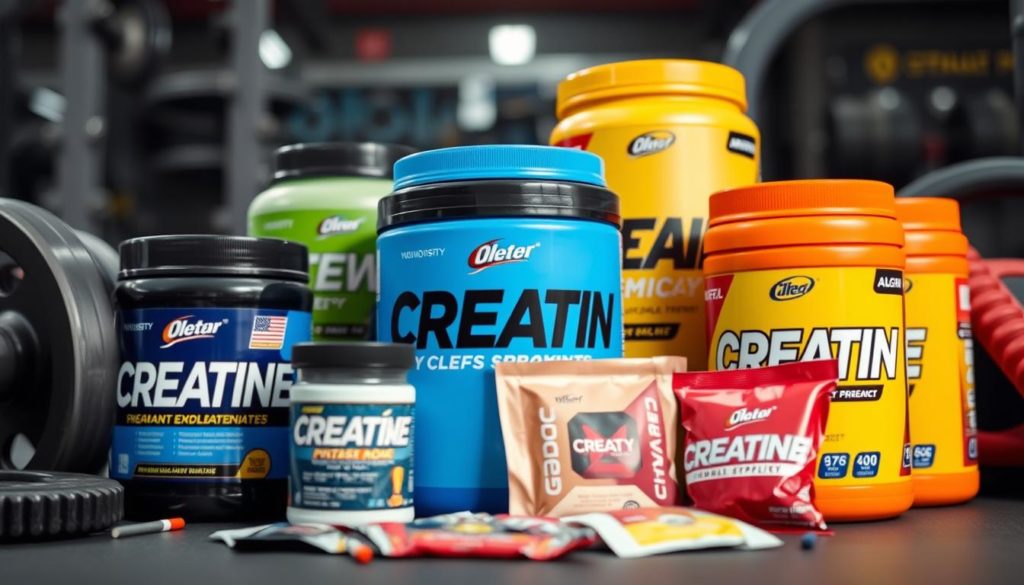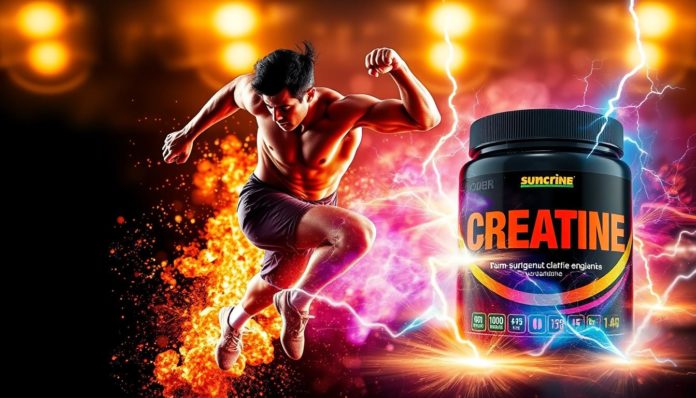Creatine is key for those aiming high in sports and fitness. It’s not just a trend but backed by science. It boosts power, endurance, and recovery, helping athletes reach new heights.
With more people using supplements, creatine is a top choice for athletes. It’s perfect for anyone looking to improve their performance. Find out how it can power your muscles, helping you achieve peak performance.
What is Creatine and How Does it Enhance Physical Performance?
Creatine is a natural substance in our muscles. It helps us produce energy when we do intense workouts or lift weights. It’s a favorite among athletes because it boosts strength, builds lean muscle, and gives a quick energy boost during intense activities. Benefits of creatine are well-known in sports nutrition, making it a key supplement for better physical performance.
Creatine works by making more creatine and phosphocreatine in our muscles. This helps keep energy up during intense exercises like weightlifting or sprinting. It helps athletes last longer and perform better, delaying when they get tired.

Research on creatine for athletes shows big improvements, mainly in power sports like weightlifting and sprinting. Many studies prove that creatine helps athletes gain muscle, increase strength, and boost explosive power.
| Performance Indicator | Effect of Creatine |
|---|---|
| Muscle strength and output | Increases |
| Exercise recovery | Enhanced recovery rates |
| High-intensity performance | Improved efficiency |
For athletes, gym-goers, or fitness enthusiasts, the benefits of creatine are clear and backed by science. Adding creatine to your diet can help you do more exercise and get better results in various physical activities.
Exploring the Array of Creatine Benefits for Athletes
Creatine supplements are key for better athletic performance and muscle health. They help athletes perform better and grow muscles faster.
Increased Muscular Endurance and Strength
Creatine boosts muscle strength and endurance. It increases phosphocreatine, which helps make ATP during intense workouts. This lets athletes work harder and longer.
Weightlifters and track athletes love creatine for this reason. It’s a big help in their training.
Improved High-Intensity Exercise Performance
Creatine makes a big difference in high-intensity sports. It quickly boosts energy for quick, powerful movements. This is great for sports like sprinting and soccer.
Accelerates Muscle Growth

Creatine also helps muscles grow faster. It starts new muscle fibers growing and makes existing ones bigger. This is key for athletes wanting to build muscle quickly.
| Performance Factor | Impact of Creatine | Activity Example |
|---|---|---|
| Energy Production | Increases ATP availability for explosive power | Weightlifting, 100m dash |
| Endurance | Enables longer training sessions with less fatigue | Long-distance cycling, swimming |
| Recovery | Reduces muscle damage, speeds up recovery time | High-intensity interval training (HIIT) |
| Muscle Hypertrophy | Stimulates pathways for muscle growth | Bodybuilding routines |
In short, creatine supplements are a game-changer for athletes. They boost performance and muscle growth, whether for sports, bodybuilding, or fitness.
Decoding the Different Types of Creatine Supplements
Creatine supplements are key for athletes wanting to boost their performance and recover faster. Creatine monohydrate is the most studied and trusted type. But, new forms of creatine have come out, each with its own benefits.
Creatine Monohydrate: The Gold Standard
Creatine monohydrate is known for its impact on high-intensity workouts and muscle growth. It’s efficient and safe, helping with energy for quick and powerful movements. It’s also affordable, making it a favorite among many athletes.
Advanced Forms of Creatine: Hydrochloride, Ethyl Ester, and More
New creatine types have emerged as science improves. Creatine hydrochloride (HCL) and creatine ethyl ester are designed for better absorption. They’re for those who can’t take regular creatine or want faster results.
Here’s a quick look at creatine monohydrate and two advanced types. It shows their main features and who they’re best for:
| Type of Creatine | Solubility | Cost-effectiveness | Recommended For |
|---|---|---|---|
| Creatine Monohydrate | Standard | High | General Athletes |
| Creatine Hydrochloride (HCL) | High | Medium | Athletes with Digestive Sensitivity |
| Creatine Ethyl Ester | High | Low | Advanced Athletes seeking quick absorption |
Choosing between creatine monohydrate and newer forms depends on personal needs and goals. Each type has its own advantages. Knowing these can help athletes get the most from their supplements.
Understanding Creatine Dosage: How Much and When?
When you’re thinking about creatine supplements, knowing the right creatine dosage is key. It helps you get the most benefits without any bad side effects. Whether you’re an athlete, bodybuilder, or just trying to get fit, how much and when you take creatine matters a lot.
Figuring out the best dosage depends on several things. These include your body weight, what you want to achieve, and the type of creatine you’re using. Creatine monohydrate is the most common type. It’s usually taken in two phases: a loading phase and a maintenance phase.
The loading phase is when you take a higher dose for a few days. This quickly boosts your muscle stores. Then, you switch to a maintenance dose to keep those levels up.
- Loading Phase: You take about 20 grams a day, split into 4 servings of 5 grams each, for 5-7 days.
- Maintenance Phase: You take 3-5 grams a day.
Now, let’s look at the typical recommendations in more detail:
| Phase | Dosage | Frequency | Duration |
|---|---|---|---|
| Loading | 20 grams/day | 4 times daily | 5-7 days |
| Maintenance | 3-5 grams/day | Daily | Indefinite |
Adjust these guidelines based on how your body reacts. Some people might do well with smaller doses. Others might need more. Start with the lower end of the creatine dosage range and adjust as needed. Think about how your body reacts, how hard you’re training, and how much water you’re drinking.
Time your creatine usage right. Take it with meals or after working out to help your body absorb it better. The right timing can make a big difference, making creatine work even better when you’re eating carbs and proteins.
By carefully following these guidelines, you can use creatine supplements effectively. This helps you reach your health and fitness goals. Always talk to a healthcare provider before starting any supplements, but this is even more important for certain groups or people with health issues.
Creatine Monohydrate Vs. Other Variants: What Science Says
Choosing the right creatine supplement can affect your performance and your budget. Creatine monohydrate is backed by many studies and often compared to newer options. This section explores creatine research on both how well it works and its cost.
Comparative Studies on Effectiveness
Creatine research shows creatine monohydrate boosts muscle, strength, and exercise performance. Newer forms like creatine hydrochloride (HCL) and creatine ethyl ester don’t have much evidence of being better. Studies suggest creatine monohydrate is just as good, if not better, than these alternatives when taken as directed.
Cost-benefit Analysis of Different Creatine Types
Cost is a big factor in creatine comparison. Creatine monohydrate is both effective and affordable. Other types, like creatine HCL, might offer benefits like less water retention but cost more without being proven to work better.
| Type of Creatine | Average Cost per 100 grams | Key Benefits Claimed |
|---|---|---|
| Creatine Monohydrate | $2-$5 | Proven efficacy, extensive research support |
| Creatine Ethyl Ester | $15-$30 | Better absorption claimed |
| Creatine Hydrochloride | $10-$25 | Less bloating, smaller doses |
In summary, while other creatine types have unique benefits, creatine monohydrate is the top choice for most athletes. It offers a great balance of cost and proven effectiveness.
Creatine Use Among Different Populations
Creatine is popular among athletes and many others with health and fitness goals. It’s good to know how it helps different groups. This way, we can choose the right supplement for our needs.
Creatine for athletes boosts performance, like in sprinting and weightlifting. But, benefits of creatine go beyond sports. It might help older people think better too.
For those who aren’t athletes, creatine can help with health and preventing diseases. It’s good for keeping muscles strong, which is important as we age.
- Enhanced muscle recovery
- Improved performance in high-intensity activities
- Support for cognitive functions
- Increase in overall energy levels
Also, creatine for muscle growth isn’t just for pros. Anyone who works out can see bigger muscles and better workouts.
Safety and Popularity: Creatine is safe for many people. Adjusting how much you take can make it even safer and more effective.
Knowing how creatine affects different groups helps us make better choices. It can improve our health and how well we perform.
Maximizing Results with Creatine Cycling and Loading Phases
To get the most out of creatine supplements, it’s key to know about loading and cycling. These strategies help your muscles soak up more creatine. They also help your body stay responsive to its effects.
Description of Creatine Loading
Creatine loading means taking a bigger dose for a short time to fill up muscle stores fast. You take about 20 grams of creatine daily, split into 4 doses, for 5-7 days. This quickens the buildup of creatine in muscles, boosting strength and recovery sooner than a regular dose.
Strategies for Creatine Cycling
Creatine cycling involves alternating between loading, maintenance, and rest phases. It keeps your body from getting used to creatine too quickly. A common cycle includes:
- Loading Phase: 20 grams/day for 5-7 days
- Maintenance Phase: 5 grams/day for 4-6 weeks
- Rest Phase: No creatine for 4 weeks
This approach keeps your muscles ready to respond well to creatine. It helps you maintain peak performance for longer.
| Phase | Duration | Daily Dosage |
|---|---|---|
| Loading | 5-7 days | 20 grams |
| Maintenance | 4-6 weeks | 5 grams |
| Rest | 4 weeks | 0 grams |
Using creatine loading and cycling can make your supplement routine more effective. It helps avoid plateaus and keeps your performance at its best. You’ll see real gains in strength and muscle over time.
Common Myths and Misconceptions About Creatine Debunked
Despite its popularity, many myths about creatine exist in the fitness world. It’s important to clear up these creatine myths to help users make smart choices. We’ll look at some common wrong ideas and replace them with true creatine facts.
One big myth is that creatine causes dehydration and cramping. But research shows it can actually help the body hold onto water in muscles. This might improve hydration and lower the chance of cramps, which goes against what many think about creatine side effects.
- Myth: Creatine causes kidney damage in healthy individuals.
- Fact: Many studies have found no proof of this when creatine is used correctly.
- Myth: Creatine is a steroid and can be banned in sports.
- Fact: Creatine is naturally found in the body and is a legal supplement, not a steroid.
- Myth: All creatine supplements are the same.
- Fact: There are different types of creatine, like creatine monohydrate and creatine hydrochloride. Each has its own absorption rate and effectiveness.
Clearing up these myths helps educate people and shows the benefits of creatine when used right in a fitness plan.
| Myth | Truth | Impact on Performance |
|---|---|---|
| Creatine causes water retention | Helps keep water in muscles, aiding in muscle growth | Can be positive, helping with muscle recovery and growth |
| It’s only useful for bodybuilders | Helps with high-intensity training and muscle endurance in many sports | Useful for different athletic needs |
| Creatine leads to fat gain | No direct link to fat gain; weight gain is usually from muscle growth | Focuses on muscle, not fat, improving body composition |
Knowing these facts helps clear up creatine myths and shows the low creatine side effects. This encourages a more scientific approach to using supplements.
How Creatine Supplementation Fits Within a Nutrition Plan
Adding creatine to your daily diet can boost health and sports performance. To get the most out of optimal creatine absorption, think about the creatine dosage, when to take it, and with what foods.
Timing Creatine with Meals for Optimal Absorption
Taking creatine with a meal can make it work better. Carbs and proteins in your meal raise insulin levels. This helps creatine get into your muscles more easily. For best results, pair creatine with meals rich in carbs and proteins.
Synergies Between Creatine and Other Nutrients
Some nutrients work better with creatine, making it more effective. For example, eating simple carbs with creatine boosts muscle uptake. Beta-alanine, another supplement, can increase muscle carnosine when taken with creatine. This improves strength and endurance.
Adjust your creatine dosage timing for better results. Taking it after a workout, with a meal that has proteins and carbs, can help with recovery and muscle growth.
Recognizing and Managing Possible Creatine Side Effects
Creatine is popular for boosting athletic performance and muscle growth. But, knowing the side effects and how to handle them is key for staying healthy. This part talks about common side effects and when to get help from health experts.
Common Side Effects and How to Mitigate Them
Dehydration and gastrointestinal distress are common side effects. Drinking more water helps a lot. It makes the body’s creatine levels safer and cuts down on cramps and stomach problems.
- Drink at least 20-30% more water each day when taking creatine.
- Take creatine doses throughout the day to ease stomach upset.
Weight gain is another side effect, mainly from water in muscles. It’s usually safe but can worry athletes in weight-sensitive sports. Lowering the creatine dose can help control this.
When to Consult a Professional Regarding Creatine Usage
If you keep getting bad effects or have health issues, see a doctor. This is very important for people with kidney or liver problems. Creatine needs these organs to work right.
- Unusual fatigue or muscle cramps
- Persistent gastrointestinal discomfort
- Concerns about interactions with other medications
Being proactive about side effects lets you use creatine safely. Talking to health experts gives you advice that fits your health and fitness goals.
The Role of Creatine in Recovery and Injury Prevention
Exploring creatine recovery shows its key role in refilling energy after exercise. It helps restore adenosine triphosphate (ATP) quickly. This means less time waiting to start the next workout, helping athletes avoid overdoing it.
But creatine does more than just boost energy. It also aids in muscle repair and cuts down inflammation. These benefits are key in preventing injuries during sports. Creatine helps the body fix itself faster, making athletes ready for their next challenge.
While creatine is known for improving performance, its role in recovery is just as important. Adding it to a recovery plan can greatly enhance athletic performance. It supports long-term health and readiness for athletes.
FAQ
What are the main benefits of creatine supplementation for athletes?
Creatine boosts muscle strength and endurance. It also improves performance in intense exercises. Plus, it helps muscles grow, leading to better athletic performance.
How does creatine work within the body to improve physical performance?
Creatine helps make more ATP, the body’s energy source. This is key for quick, intense activities. It makes you stronger, more powerful, and less tired during exercise.
What are some specific ways creatine can increase muscular endurance and strength?
Creatine boosts phosphocreatine in muscles. This means more ATP for exercise. It helps you lift heavier and do more intense activities, improving strength and endurance.
What is creatine monohydrate, and why is it considered the gold standard amongst creatine supplements?
Creatine monohydrate is the most studied and trusted creatine type. It’s pure, well-absorbed, and safe. Its effectiveness is backed by many scientific studies, making it the top choice.
How should creatine be dosed for optimal results, and are there any timing considerations?
Take 3-5 grams of creatine monohydrate daily. For best results, take it after working out or with carbs and protein. Adjust based on your goals, weight, and diet.
How do the different types of creatine compare in terms of effectiveness?
Creatine monohydrate is the most proven. Other types, like hydrochloride and ethyl ester, claim better absorption or less bloating. But studies often favor monohydrate for its proven benefits and value.
Is creatine supplementation appropriate for all demographics, including non-athletes?
Creatine helps athletes and non-athletes alike. It boosts health, supports muscle, and aids metabolism. But, consider your health needs first.
What is creatine loading, and is it a necessary part of a supplementation plan?
Creatine loading means taking 20 grams daily for 5-7 days to quickly fill muscles. Then, take 3-5 grams daily. Loading can give quick gains, but it’s not always needed for long-term benefits.
Can you debunk common myths about creatine?
Yes, myths say creatine causes dehydration, cramping, or kidney damage. But, science shows it’s safe when used correctly and with enough water.
How can creatine fit within a balanced nutrition plan?
Mix creatine with meals that have protein and carbs. This helps your body absorb it better, thanks to insulin from carbs.
What are some possible side effects of creatine, and how can they be managed?
Side effects like bloating or digestive issues can happen. Reduce the dose, spread out intake, or try easier-to-digest forms like micronized monohydrate.
How does creatine support recovery and potentially prevent injury during training?
Creatine reduces muscle damage and inflammation. It also helps ATP stores recover faster and may lessen soreness. While more research is needed, it could lower injury risk by improving strength and training capacity.


